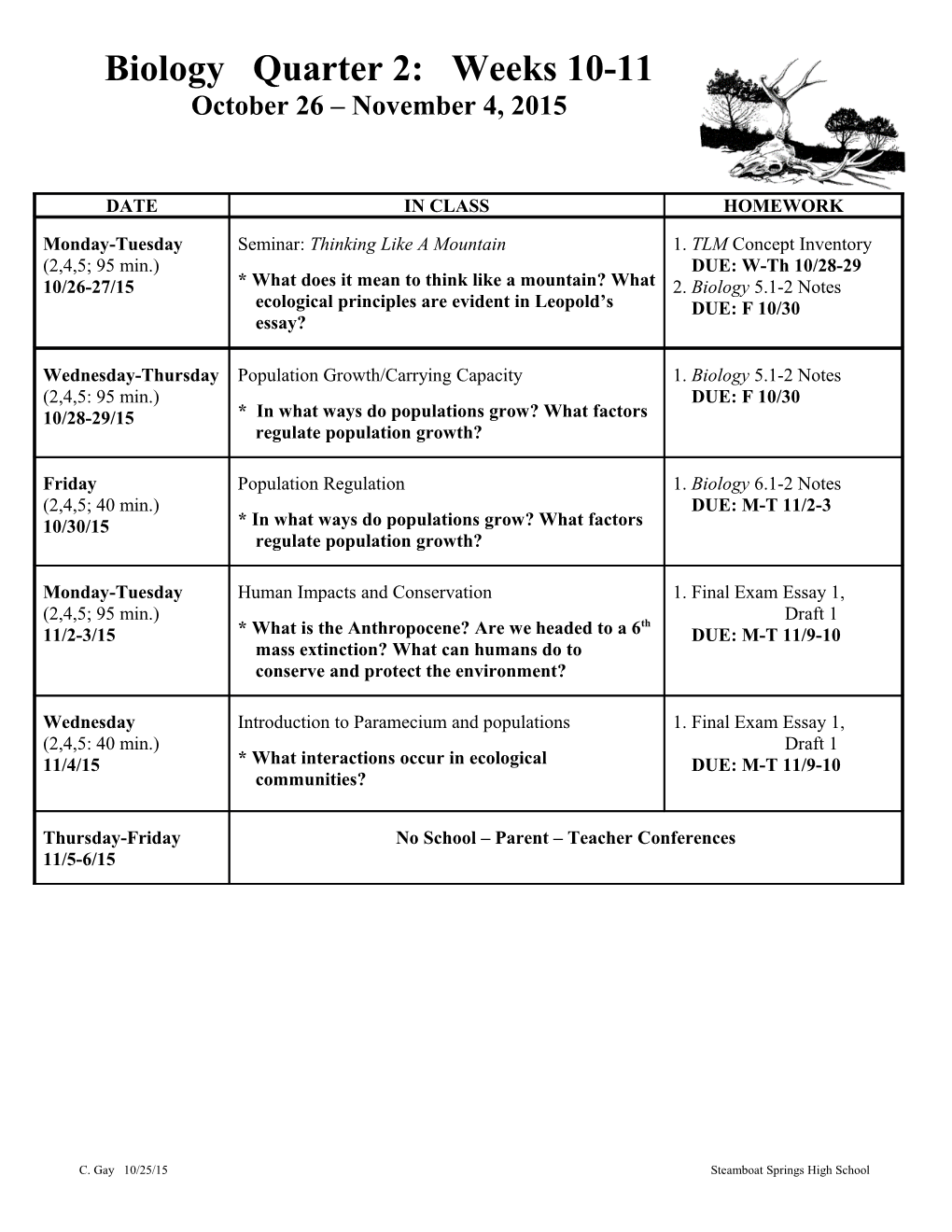Biology Quarter 2: Weeks 10-11
October 26 – November 4, 2015
DATE / IN CLASS / HOMEWORKMonday-Tuesday
(2,4,5; 95 min.)
10/26-27/15 / Seminar: Thinking Like A Mountain
*What does it mean to think like a mountain? What ecological principles are evident in Leopold’s essay? / 1. TLM Concept Inventory
DUE: W-Th10/28-29
2. Biology 5.1-2 Notes
DUE: F 10/30
Wednesday-Thursday
(2,4,5: 95 min.)
10/28-29/15 / Population Growth/Carrying Capacity
* In what ways do populations grow? What factors regulate population growth? / 1. Biology 5.1-2 Notes
DUE: F 10/30
Friday
(2,4,5; 40 min.)10/30/15 / Population Regulation
* In what ways do populations grow? What factors regulate population growth? / 1. Biology 6.1-2 Notes
DUE: M-T 11/2-3
Monday-Tuesday
(2,4,5; 95 min.)
11/2-3/15 / Human Impacts and Conservation
* What is the Anthropocene? Are we headed to a 6th mass extinction? What can humans do to conserve and protect the environment? / 1. Final Exam Essay 1,
Draft 1
DUE: M-T 11/9-10
Wednesday
(2,4,5: 40 min.)11/4/15 / Introduction to Paramecium and populations
* What interactions occur in ecological communities? / 1. Final Exam Essay 1,
Draft 1
DUE: M-T 11/9-10
Thursday-Friday 11/5-6/15 / No School – Parent – Teacher Conferences
Topical Understanding
Populations, collections of individuals of the same species that regularly interbreed, are the functional unit of both ecology and evolution. Most populations, under ideal conditions, tend to grow exponentially until one or more environmental variables limits grow. Population size is regulated by both biotic and abiotic factors. These factors can be categorized as density-dependent or density-independent. Carrying capacity describes the maximum number of organisms the ecosystem can support over time.
Because humans interact with local and global food webs and biogeochemical cycles, human activity has changed the flow of energy and the cycling of nutrients in the biosphere. These changes have occurred at both local and global levels. While the Earth’s resources can be classified as renewable or nonrenewable, abiotic (land, mineral, air, water) or biotic (forest, ocean, biodiversity). The rate at which these resources are use and/or consumed determines if their use can be sustained over time. Human use of resources and the effects of this use over time have resulted in complicated ethical and political dilemmas.
Essential Questions
- What would happen if a population grew exponentially forever?
- How do the ecological pyramids and feeding relationships serve as factors in regulating population size?
- Are humans beginning to experience density-dependent population regulating factors?
- Can humans continue to change the carrying capacity of the planet through improved technology? In other words, is there an ultimate carrying capacity?
- While all living organisms impact and change the environment, how have humans impacted/changed the environment to a greater extent than any other species? Is the extent of our impact justifiable?
- Are we currently experiencing a “tragedy of the commons”? Is sustainable use possible?
- Do humans have a moral obligation to future generations for the condition of the Earth and its resources?
Areas of Focus
= Population Growth
= Limits to Growth
= Human Activities and their Impact on the Biosphere
= Biodiversity and Conservation Biology
Knowledge and Skills
= Population Growth
Characteristics of populations
- Geographic distribution
- Population density
- Growth
- Age structure
Population growth
- Births
- Deaths
- Immigration
- Emigration
Exponential
Logistic growth
- Carrying capacity
= Limits to Growth
Limiting factors
Density-dependent factors
- Competition
- Predation (predator –prey relationships)
- Parasitism and disease
Density-Independent factors
C. Gay 10/25/15Steamboat Springs High School
